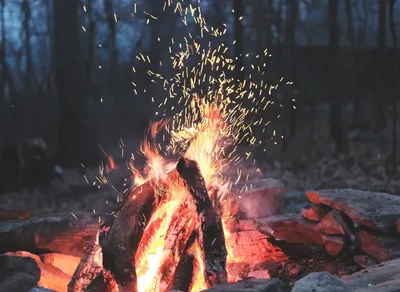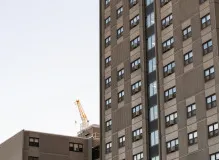For over long years, we have diligently conducted independent research and product testing. When you make a purchase through our links, we may earn a commission.
Prevent Flat Fire Hazards with These 5 Essential Tips!
Created: 3 weeks ago

49 min Read
Fire safety is a critical aspect of maintaining a safe and secure living or working environment. The devastating consequences of fires, particularly in residential and commercial buildings, highlight the importance of being proactive in preventing and preparing for such disasters. One of the key concerns in fire safety is the occurrence of flat fires, which can have disastrous outcomes if not addressed promptly and effectively. In this blog post, we will explore the significance of fire safety awareness, with a specific focus on the prevention and management of flat fires.
Understanding Flat Fires
Flat fires, also known as apartment fires or condominium fires, are fires that occur within multi-unit residential buildings. While these fires can originate from various sources such as electrical faults, cooking accidents, or arson, the potential for rapid spread across multiple units is a major concern.
The Risks and Consequences
The risks and consequences of flat fires are immense, posing a significant threat to life, property, and the environment. In densely populated areas, such fires have the potential to affect a large number of individuals in a short period. The structural integrity of the building may also be compromised, leading to the collapse of floors or ceilings. Additionally, the release of toxic smoke and gases can cause serious health issues and even fatalities. It is imperative to take proactive measures to prevent flat fires and minimize their impact if they do occur.
Preventing Flat Fires
Prevention is always the first line of defense when it comes to fire safety. Implementing proper preventive measures significantly reduces the risk of flat fires. Some key steps to consider include:
- Regularly inspecting and maintaining electrical systems to identify and address potential hazards.
- Practicing safe cooking habits, such as never leaving the stove unattended and keeping flammable materials away from heat sources.
- Ensuring proper storage and disposal of flammable substances, such as chemicals, fuels, and cleaning agents.
- Installing and regularly testing smoke detectors and fire alarms to ensure early detection and warning.
- Educating residents on fire safety protocols, including evacuation procedures and the proper use of fire extinguishers.
Managing Flat Fires
Despite our best efforts in prevention, flat fires can still occur. Therefore, it is crucial to have effective strategies in place to manage such emergencies. Some key steps for managing flat fires include:
- Promptly notifying emergency services and providing them with accurate information about the fire location and situation.
- Alerting neighboring units to ensure timely evacuation and prevent the spread of the fire.
- Following designated evacuation routes and assembly points as per the building's emergency plan.
- Staying low and covering your mouth and nose with a cloth to minimize smoke inhalation when leaving the building.
- Never using elevators, as they may malfunction during a fire. Use stairwells instead.
- Assisting others, particularly those with mobility issues or disabilities, to evacuate safely.
Conclusion
In conclusion, fire safety awareness is vital in preventing and managing flat fires. By implementing preventive measures and being prepared for emergencies, we can significantly reduce the occurrence and impact of such incidents. Remember, fire safety is everyone's responsibility, and by staying informed and proactive, we can help create safer living and working environments. Stay safe and protect what matters most: our lives and our homes.
Flat fires can occur due to a variety of reasons, often resulting from common causes that can easily be prevented. Understanding these causes is crucial in order to take proactive measures to minimize the risk of a flat fire. Let's explore some of the most frequent causes and ways to prevent them:
-
Electrical faults: Electrical failures, such as faulty wiring or overloaded circuits, can lead to flat fires. Regular inspections by certified electricians can help identify potential hazards and ensure that the electrical system is safe and up to code.
-
Cooking accidents: Unattended cooking, especially with high heat sources like stoves and ovens, is a leading cause of flat fires. It's important to stay in the kitchen while cooking and avoid leaving flammable materials, such as towels or paper, near heat sources.
-
Smoking: Careless disposal of smoking materials, such as cigarette butts, can easily ignite flammable materials and lead to a flat fire. Smokers should always use designated smoking areas and ensure that cigarette butts are properly extinguished.
-
Heating equipment: Faulty or poorly maintained heating equipment, such as space heaters or furnaces, can pose a fire hazard. Regular maintenance and proper ventilation are crucial to minimize the risk of a fire.
-
Candles: Unattended candles or candles placed near flammable materials can quickly escalate into a flat fire. It's important to always keep candles in stable holders and extinguish them before leaving a room.
-
Arson: While less common, arson can still be a cause of flat fires. Ensuring that the building has proper security measures in place, such as surveillance cameras and secure access, can help prevent deliberate acts of arson.
By being aware of these common causes, residents and property owners can take proactive steps to prevent flat fires. Regular inspections, proper maintenance, and educating residents about fire safety protocols are essential in creating a safe living environment. Remember, prevention is always better than dealing with the devastating consequences of a flat fire. Stay vigilant and prioritize fire safety at all times.
To effectively prevent and manage flat fires, it is essential to pay close attention to electrical appliances and wiring. Faulty electrical systems are a common cause of flat fires, making regular inspections and maintenance crucial.
Inspecting electrical systems regularly helps identify potential hazards before they escalate into dangerous situations. Look for any signs of damaged or frayed wiring, loose connections, or overheating appliances. If you notice any issues, immediately seek the assistance of a qualified electrician to address the problem.
It is also important to unplug appliances when not in use and avoid overloading electrical sockets. Overloaded circuits can overheat, increasing the risk of electrical fires. Furthermore, never leave appliances running for extended periods or overnight, as this can lead to overheating and potential fire hazards.
Another important tip is to use electrical appliances safely. Follow manufacturer guidelines when using them and avoid using damaged or faulty devices. Ensure that all electrical cords are in good condition and not cracked or worn out. Avoid running cords under carpets or rugs, as this can cause overheating and potential fires.
Taking these precautions significantly reduces the risk of electrical fires in flats. By being proactive and diligent in monitoring electrical appliances and wiring, you are taking a crucial step towards enhancing fire safety and protecting your property and the well-being of all residents.
Remember, fire safety is everyone's responsibility, and by prioritizing prevention and adhering to safety guidelines, we can minimize the occurrence and impact of flat fires.
When it comes to preventing flat fires, one area of utmost importance is safe cooking practices. The kitchen is often the most common area where fires start, making it essential to be diligent and cautious. By adopting and following safe cooking practices, you can significantly reduce the risk of a flat fire.
Here are some key tips to keep in mind when it comes to safe cooking:
-
Stay attentive: Never leave the stove unattended while cooking. It only takes a momentary distraction for a fire to start. Avoid answering phone calls or leaving the kitchen for extended periods when cooking.
-
Keep flammable items away: Be mindful of where you place flammable items, such as dish towels, cooking oils, or paper products. Keep them away from the stove to minimize the risk of accidental contact with open flames or hot surfaces.
-
Use caution with grease: Cooking with oil or grease can be hazardous if not handled properly. Heat oil slowly and carefully, and be cautious of hot oil splatters. If grease catches fire, do not attempt to extinguish it with water. Instead, use a fire extinguisher or cover the pan with a metal lid to smother the flames.
-
Clear the area: Ensure that the cooking area is clear of any clutter or items that could catch fire. Keep flammable materials, such as kitchen towels or oven mitts, away from the stove or oven.
-
Monitor the temperature: When using the oven, check regularly to ensure that the temperature is set correctly. Avoid placing items that are not oven-safe inside the oven, as they can ignite and start a fire.
-
Practice proper ventilation: Adequate ventilation in the kitchen is crucial to prevent the buildup of smoke or cooking fumes. Make sure your kitchen is equipped with an exhaust fan or open nearby windows to allow for proper airflow.
By following these safe cooking practices, you can greatly reduce the risk of a flat fire caused by cooking accidents. Remember, prevention is key when it comes to fire safety, and taking proactive measures can help safeguard your home and the well-being of its occupants. Stay alert, stay cautious, and prioritize fire safety in your daily cooking routine.
Proper smoking etiquette is essential not only for personal comfort but also for fire safety, as cigarettes are a common cause of flat fires. Follow these tips to ensure a fire-safe smoking experience:
-
Designate a designated smoking area: It is crucial to have a designated area for smoking that is away from flammable materials, such as furniture, curtains, or vegetation. By creating a designated smoking area, you can minimize the risk of accidental fire ignition.
-
Use fire-safe ashtrays: When smoking, always make sure to use fire-safe ashtrays that are deep and made of non-combustible material. This helps in containing ash and cigarette butts and reduces the risk of fire spreading.
-
Never smoke in bed or while drowsy: Smoking in bed is extremely dangerous as it increases the likelihood of accidental fires. The risk is even higher if you are drowsy or under the influence of alcohol or medication. Always make sure to fully extinguish your cigarette before going to bed or when feeling drowsy.
-
Dispose of cigarettes properly: Properly extinguish cigarettes in the designated ashtray and never dispose of them in trash cans, potted plants, or other flammable containers. Carelessly discarded cigarette butts can smolder for hours and potentially start a fire.
-
Never leave a lit cigarette unattended: It is essential to never leave a lit cigarette unattended, even for a short period. Make sure to fully extinguish the cigarette before stepping away from it.
-
Keep lighters and matches out of reach: If you have children or pets in your home, it is crucial to keep lighters and matches out of their reach. Store them in a secure location to prevent accidental fires caused by curious hands or paws.
-
Be mindful of windy conditions: Wind can quickly spread sparks and embers, increasing the risk of fire. If it is a windy day, try to find a sheltered area for smoking or consider postponing it until the weather conditions improve.
-
Do not smoke near flammable liquids: Avoid smoking near flammable liquids, such as gasoline, paint thinners, or propane tanks. Vapors from these substances can ignite easily and lead to a potentially dangerous situation.
Remember, practicing proper smoking etiquette not only reduces the risk of flat fires but also promotes a considerate and respectful environment for those around you. By incorporating these tips into your smoking routine, you can contribute to fire safety while enjoying your smoking experience.
Candles and open flames can pose a significant risk when it comes to flat fires. It is crucial to exercise caution and take necessary precautions when using them in your living space.
1. Always supervise: Never leave candles or open flames unattended. It only takes a moment for a fire to start and spread. Make sure to extinguish candles before leaving a room or going to bed.
2. Keep them away from flammable materials: Ensure there are no flammable materials like curtains, papers, or fabrics near candles or open flames. It's essential to maintain a clear and safe zone around any open flame to prevent accidental ignition.
3. Use stable holders: Place candles in sturdy, non-flammable holders that can securely hold them. This will help minimize the risk of them tipping over and starting a fire.
4. Consider alternatives: If you have concerns about using open flames, consider using flameless alternatives like battery-operated candles or LED lights. These can provide a similar ambiance without the risk of fire.
5. Properly extinguish flames: Before leaving a room or going to bed, ensure that all candles and open flames are fully extinguished. Use a candle snuffer or a metal lid to smother the flame, and make sure the wick is no longer glowing or smoking.
6. Educate others: Share fire safety knowledge with your family, friends, and neighbors. Make sure everyone understands the risks associated with candles and open flames and the necessary precautions to take.
By being mindful of candles and open flames, we can significantly reduce the risk of flat fires. Taking these simple yet important steps can help ensure the safety and well-being of everyone in your apartment building or condominium. Stay vigilant, and remember that prevention is key in fire safety.
Implementing a fire escape plan is a crucial step in effectively managing the risk of flat fires. Having a well-thought-out plan in place ensures that residents can evacuate safely and swiftly in the event of a fire emergency. Here are some key tips for creating and implementing a fire escape plan in your flat:
-
Develop a Plan: Start by creating a detailed plan that outlines escape routes and emergency procedures. Identify multiple exits, including stairwells, windows, and alternative routes. Highlight these routes on a floor plan of your flat, and ensure that everyone in the household is familiar with them.
-
Communicate and Educate: Share the fire escape plan with all residents of the flat, including children and elderly family members. Take the time to educate everyone on the importance of fire safety and the specific actions to take in case of a fire. Reinforce the plan through regular drills and discussions.
-
Designate Meeting Points: Choose a designated meeting point outside the building where all members of the household can gather safely after evacuating. Ensure that this meeting point is easily identifiable and away from potential hazards. This will help you quickly account for everyone and notify emergency services if someone is missing.
-
Practice Regularly: Conduct fire drills to practice the fire escape plan at least twice a year. Repetition and familiarity are key to ensuring a calm and efficient response during an actual emergency. Practice different scenarios, including escaping in the dark or when certain exits are blocked, to prepare for unexpected situations.
-
Test Smoke Alarms: Regularly test and maintain the smoke alarms in your flat to ensure they are in proper working condition. Smoke alarms play a critical role in alerting residents to a fire and providing early warning. Install smoke alarms in every sleeping area, hallway, and common areas of your flat, and replace their batteries as needed.
-
Stay Low and Crawl: In a fire situation, the air closest to the ground will be the least smoke-filled. Teach everyone in your household to stay low and crawl when evacuating to minimize smoke inhalation. Covering your mouth and nose with a cloth can also provide some protection from smoke.
-
Never Use Elevators: It is essential to emphasize that elevators should never be used during a fire. Elevators can malfunction or become trapped, posing extreme danger to occupants. Always use stairwells and safe escape routes when evacuating a building.
-
Ensure Accessible Exits: If someone in your household has mobility limitations, ensure that exit routes are accessible for them. Consider installing exit ramps or exploring alternative options to ensure their safe evacuation. Communicate these arrangements with emergency services to receive appropriate assistance if needed.
By implementing a fire escape plan and consistently practicing it, you are taking proactive steps to protect yourself, your loved ones, and your property in the event of a flat fire. Stay alert, stay informed, and prioritize fire safety to reduce the risks associated with flat fires.
Flat fires can have devastating consequences, making it crucial to prioritize fire safety and prevention in residential and commercial buildings. With the potential for rapid spread and the risk to life, property, and the environment, it is essential to raise awareness and implement effective measures to mitigate flat fire hazards.
🔥Preventing flat fires🔥
One of the most effective ways to prevent flat fires is through regular inspections and maintenance of electrical systems. By identifying and addressing potential hazards, such as faulty wiring or overloaded circuits, the risk of fire can be significantly reduced.
Kitchen safety is also vital in preventing flat fires. 🔥Practicing safe cooking habits🔥, such as never leaving the stove unattended and keeping flammable materials away from heat sources, can help prevent accidental fires. It is also essential to be cautious when using appliances such as toaster ovens, microwaves, and electric fryers, ensuring they are used correctly and not left operating unsupervised.
Proper storage and disposal of flammable substances play a crucial role in fire prevention. 🔥Ensuring proper storage🔥 of chemicals, fuels, and cleaning agents in designated areas away from sources of heat can help minimize the risk of fire. Additionally, 🔥disposing of these substances correctly🔥, following all safety guidelines, ensures they do not become potential ignition sources.
Early detection is key in preventing the escalation of flat fires. Installing and regularly testing smoke detectors and fire alarms is essential to ensure their proper functioning. These devices should be strategically placed throughout the building, including in bedrooms and common areas, to provide early warning in the event of a fire. Regular maintenance and 🔥routine battery checks🔥 are essential to ensure their reliability.
Fire safety education is another critical component of preventing flat fires. By 🔥educating residents🔥 on fire safety protocols, such as evacuation procedures and the proper use of fire extinguishers, individuals are equipped with the knowledge and skills to respond effectively in case of an emergency. Conducting regular fire drills can also help reinforce these protocols and ensure that everyone knows what to do in the event of a fire.
Flat fire prevention requires a collective effort from both residents and building management. By implementing these preventive measures and fostering a culture of fire safety awareness, the risk of flat fires can be significantly reduced. It is everyone's responsibility to prioritize fire safety and work together to protect lives and property from the devastating consequences of flat fires.
Regularly checking and maintaining electrical wiring and appliances is a crucial step in preventing flat fires. Faulty electrical systems are a common cause of residential fires, making it essential to prioritize their inspection and maintenance.
🔥 One of the 🔍 key 🔑 measures 🔌 in preventing 🚫 flat fires is by regularly checking 🔬 the electrical 👷♂️ wiring and appliances within your 🏠 home. 🏢 Whether you live in a house 🏡 or an 🏢 apartment, electrical 🔌 systems can deteriorate over 🕐 time, leading to potential hazards.
To avoid such risks, it is important ❗ to have a 🧑🔧 qualified electrician 💡 inspect 🕵️♂️ and assess the condition of your electrical systems. They can identify 🔎 any issues such as exposed wires, overloaded circuits, or outdated wiring. By addressing 😊 these problems ✅ promptly, you can significantly reduce the risk of electrical fires.
👨🔧 It is also important to 🛠 properly maintain your electrical appliances. Over time, appliances can develop faults or become worn out, making them potentially dangerous fire hazards. Regularly cleaning, inspecting, and servicing your appliances can help ensure they are in proper working condition and minimize the risk of electrical malfunctions.
⚡🔧 Remember to ✨ unplug appliances when not in use, avoid overloading electrical outlets, and use surge protectors to add an extra layer of safety. Additionally, never attempt to repair or modify electrical wiring or appliances yourself unless you are a qualified professional.
By taking these precautionary measures, you can greatly reduce the risk of flat fires caused by electrical faults. Regular inspections and maintenance not only enhance the safety of your home or apartment but also provide you with peace of mind.
So, remember to regularly check and maintain your electrical wiring and appliances to ensure a fire-safe living environment.
Candles and other open flames can add a cozy ambiance to our living spaces, but they can also pose a significant fire risk if not handled with caution. 🔥 It is important to follow proper safety protocols when using candles or any other open flames in your flat to prevent a potential flat fire. Here are some tips to help you stay safe:
-
🔥 Never leave candles unattended: Always extinguish candles before leaving the room or going to bed. Leaving a burning candle unattended is one of the leading causes of flat fires.
-
🔥 Keep candles away from flammable materials: Ensure that candles are placed on sturdy, heat-resistant surfaces and kept away from curtains, bedding, paper, or any other items that can easily catch fire.
-
🔥 Maintain a safe distance: Make sure that candles are placed at least one foot away from any other objects, including other candles. This helps to prevent accidental tipping or contact with flammable materials.
-
🔥 Use candle holders: Always use proper candle holders that are designed to catch melted wax and prevent it from spilling onto surfaces. This provides an additional layer of protection against potential fires.
-
🔥 Opt for flameless alternatives: Consider using flameless candles or LED lights as a safe alternative to traditional candles. These can still provide a warm and cozy glow without the risk of an open flame.
-
🔥 Extinguish candles properly: Use a snuffer or carefully blow out the candle flame to extinguish it. Avoid using water, as it can cause the wax to splatter and spread the fire.
Remember, being cautious with candles and open flames is essential in preventing flat fires. By implementing these simple safety measures, you can enjoy the ambiance they offer while keeping your flat and loved ones safe from the potential danger of a fire.
When it comes to fire safety in the kitchen, practicing safe cooking habits is essential. This not only reduces the risk of flat fires but also ensures the safety of everyone in the household. Here are some tips to keep in mind:
-
Never leave cooking unattended: Whether you're frying, boiling, or baking, it's crucial to stay vigilant and never leave the kitchen while cooking. Flat fires can easily occur if a pot or pan overheats, oils catch fire, or food spills onto the stove.
-
Keep flammable materials away from heat sources: It's important to ensure that flammable materials like kitchen towels, paper towels, oven mitts, or plastic utensils are kept at a safe distance from the stove. These items can quickly ignite if they come into contact with a hot burner.
-
Use cooking appliances properly: Follow the manufacturer's instructions when using cooking appliances such as stovetops, ovens, toasters, or microwaves. Improper use or overloading can lead to a potential fire hazard.
-
Clean cooking surfaces and appliances: Regularly cleaning cooking surfaces, ovens, and toaster trays helps remove grease buildup, which can be a fire risk. Grease residue can catch fire when exposed to high heat.
-
Be cautious with oils and fats: Oils and fats have a low ignition point and can easily ignite if they reach their smoking point. Never heat oil or fat beyond its recommended temperature, and be careful when adding food to hot oil to avoid splattering.
-
Use a timer: Using a timer while cooking can help prevent forgetting about food on the stove or in the oven. This reduces the risk of leaving cooking unattended and potentially starting a fire.
-
Have a lid nearby: Keep a lid or a cookie sheet within reach while cooking. If a small fire starts in a pan, sliding the lid over the pan can smother the flames and extinguish the fire. Avoid using water to put out a grease fire, as it can make the situation worse.
By following these safe cooking habits, you can significantly decrease the likelihood of a flat fire in your kitchen. Remember, fire safety is everyone's responsibility, and taking proactive measures can help keep you and your loved ones safe from the devastating consequences of a fire.
Smoke detectors and fire extinguishers are essential devices for early detection and suppression of flat fires. By installing smoke detectors in your apartment, you can receive timely warnings in case of a fire, allowing you to take immediate action and evacuate safely. These detectors are designed to sense smoke particles in the air and emit a loud alarm to alert residents. It is crucial to regularly test the functionality of your smoke detectors to ensure they are in good working condition.
In addition, having fire extinguishers readily available in your apartment can help you quickly extinguish small fires before they escalate. A fire extinguisher is a portable device that releases a targeted stream of firefighting agent, such as water or foam, to suppress flames and minimize fire damage. Properly maintaining and inspecting your fire extinguishers is important to ensure they are fully charged and ready for use in case of an emergency.
When installing smoke detectors and fire extinguishers, it is essential to follow the manufacturer's instructions and place them strategically throughout your apartment. In general, it is recommended to install smoke detectors in each sleeping area, outside bedrooms, and on every level of the apartment. Fire extinguishers should be easily accessible and placed in areas where fires are most likely to occur, such as the kitchen, utility rooms, and near electrical appliances.
While smoke detectors and fire extinguishers are effective tools for fire safety, it is important to remember that they are not a substitute for proper preventive measures and a comprehensive fire safety plan. Regularly reviewing and practicing evacuation procedures, conducting fire drills, and educating yourself and your family members about fire safety tips can greatly enhance your preparedness and minimize the risks of flat fires.
Creating and practicing a fire escape plan is a crucial step in preparing for flat fires. This proactive measure can significantly increase your chances of safely evacuating the building in the event of a fire emergency. Follow these essential tips to create and practice an effective fire escape plan:
-
Plan Ahead: Take the time to create a detailed fire escape plan specific to your flat and building layout. Identify all possible exits, including stairwells, fire escapes, and windows. Ensure that everyone in your household is familiar with the plan.
-
Designate Meeting Points: Choose two meeting points, one near the building and another at a safe distance away. This will allow you to account for all individuals and ensure everyone has safely evacuated. Practice evacuating to these meeting points during drills.
-
Know Multiple Exits: Familiarize yourself with all available exit routes from your flat. In the event that one exit is blocked or unsafe, you can quickly adapt and choose an alternative route.
-
Practice Regularly: Conduct fire drills at least twice a year to ensure that everyone in your household knows the escape routes and procedures. Make sure to simulate different scenarios, such as escaping through smoke-filled hallways, and practice crawling low to the ground to avoid smoke inhalation.
-
Test Smoke Alarms: Regularly test and maintain smoke alarms throughout your flat. Change the batteries at least once a year, and immediately replace any malfunctioning or expired alarms.
-
Communicate: Establish a communication plan with your household members in case you get separated during an evacuation. Designate a specific location or method of communication to regroup and ensure that everyone is out of danger.
-
Consider Special Needs: If you live with individuals with special needs, such as mobility challenges or hearing impairments, take their requirements into account when creating your fire escape plan. Make sure there are appropriate arrangements in place to assist them during an emergency.
-
Stay Informed: Stay updated on the fire safety regulations and protocols specific to your building. Familiarize yourself with any emergency evacuation plans, including designated exit routes and assembly points.
By creating and practicing a fire escape plan, you empower yourself and your household to respond effectively and efficiently in the event of a flat fire. Preparation is key, and your proactive efforts can ultimately save lives. Remember to review and update your fire escape plan periodically to reflect any changes in your flat or building layout. Stay safe and prioritize fire safety in your living space.
In conclusion, it is crucial to take proactive steps to prevent flat fire hazards and ensure the safety of residents in multi-unit residential buildings. By implementing proper preventive measures, such as regular inspections of electrical systems and practicing safe cooking habits, the risk of flat fires can be significantly reduced. Additionally, educating residents about fire safety protocols and ensuring the installation and testing of smoke detectors and fire alarms are important steps in mitigating the risks associated with flat fires.
In the event that a flat fire does occur, it is essential to have effective strategies in place to manage the situation. This includes promptly notifying emergency services, alerting neighboring units for timely evacuation, and following designated evacuation routes and assembly points as per the building's emergency plan. It is also important to stay low to minimize smoke inhalation, avoid using elevators, and assist others, especially those with mobility issues, to evacuate safely.
By prioritizing fire safety awareness and preventative measures, we can significantly reduce the occurrence and impact of flat fires, protecting lives, property, and the overall well-being of residents. Remember, it is everyone's responsibility to stay vigilant and proactive in fire safety practices to prevent and manage flat fire risks effectively.
If you are looking for additional resources on flat fires, there are several places where you can find more information and help.
-
Local Fire Departments: Contact your local fire department for resources on fire safety, prevention tips, and guidance on what to do in case of a flat fire. They can provide valuable information specific to your area and offer resources for fire safety education.
-
National Fire Protection Association (NFPA): The NFPA is a renowned organization that works to reduce the burden of fire and other hazards. They provide a wealth of resources on fire prevention, safety codes, research, and statistics. Their website offers educational materials, guidelines, and helpful tools for both individuals and professionals.
-
Publications and Websites: Numerous publications and websites focus on fire safety and provide valuable information on flat fires. Some popular magazines include "Fire Engineering," "Fire Rescue Magazine," and "NFPA Journal." Additionally, websites such as the NFPA website, FireSafety.gov, and the United States Fire Administration (USFA) offer comprehensive information and resources.
-
Local Community Centers: Local community centers often offer educational programs and workshops on fire safety. They may provide training sessions, distribute informational brochures, and host events to raise awareness about fire prevention. Check with your local community center for resources and events related to fire safety.
-
Fire Safety Organizations: There are numerous fire safety organizations that aim to raise awareness and promote fire prevention. These organizations offer resources, conduct research, and provide educational materials on fire safety. Examples include the Home Fire Sprinkler Coalition, National Fire Sprinkler Association, and the American Red Cross.
-
Insurance Companies: Reach out to your insurance company for resources and information on fire prevention and recovery. Many insurance companies offer fire safety tips and resources in their policies or on their websites. They can provide guidance on safety measures, home inspections, and insurance coverage related to flat fires.
Remember, being prepared and informed is crucial in mitigating the risks associated with flat fires. By utilizing these additional resources, you can enhance your knowledge, implement preventive measures, and effectively respond in case of a fire emergency. Stay safe and prioritize fire safety in your daily life.
Real-life Examples: Stories of flat fire incidents and their prevention
Flat fires are a common occurrence that can have devastating consequences. To illustrate the importance of fire safety and prevention, let's explore some real-life examples of flat fire incidents and the measures taken to prevent them.
-
Bold: The London Tower Block Fire: One of the most notable and tragic flat fire incidents in recent history is the Grenfell Tower fire in London in 2017. The fire, which started from a faulty refrigerator, quickly spread throughout the building due to the cladding material used on the exterior. This incident highlighted the importance of proper fire safety regulations and materials in high-rise buildings.
-
Italicized: The New York City Apartment Fire: In 2020, a devastating fire broke out in a New York City apartment building, displacing numerous families and causing significant damage. The fire was caused by an unattended stovetop, emphasizing the importance of practicing safe cooking habits to prevent such incidents.
-
Underlined: The Importance of Fire Safety Education: In a residential building in Sydney, Australia, a fire broke out due to a discarded cigarette. Fortunately, the fire was quickly extinguished because the residents had received thorough fire safety education and knew how to respond effectively. This incident demonstrates the value of providing residents with proper training and education on fire safety protocols.
Prevention is the key to avoiding flat fires and minimizing their impact. Here are some essential measures that can be taken to prevent flat fires:
- Regularly inspecting and maintaining electrical systems to identify and address potential hazards.
- Practicing safe cooking habits, such as never leaving the stove unattended and keeping flammable materials away from heat sources.
- Ensuring proper storage and disposal of flammable substances, such as chemicals, fuels, and cleaning agents.
- Installing and regularly testing smoke detectors and fire alarms to ensure early detection and warning.
- Educating residents on fire safety protocols, including evacuation procedures and the proper use of fire extinguishers.
In conclusion, flat fires are serious incidents that can result in the loss of life, property, and livelihoods. By implementing preventive measures and promoting fire safety education, we can significantly reduce the risk of flat fires and protect ourselves and our communities from this devastating hazard.
In conclusion, fire safety awareness is vital in preventing and managing flat fires. By regularly inspecting electrical systems, practicing safe cooking habits, and ensuring proper storage of flammable substances, we can effectively minimize the risk of flat fires. Installing and testing smoke detectors and fire alarms, as well as educating residents on fire safety protocols, further enhance our preparedness. However, in the event of a flat fire, it is crucial to promptly notify emergency services, alert neighboring units, and follow designated evacuation routes. By staying low and assisting others, we can ensure a safe evacuation. The key to preventing flat fires is remaining vigilant and maintaining a fire-safe environment in flats. Together, we can reduce the devastating consequences of these incidents and protect both lives and property.
Fire safety is an essential aspect of maintaining a safe and secure living environment for flat owners. Understanding the importance of fire safety is crucial for ensuring the well-being of residents and protecting their valuable properties. The potential risks and devastating consequences of flat fires underline the necessity of being proactive in implementing preventive measures and having effective strategies in place for fire management. In this article, we will delve into the significance of fire safety and provide valuable insights for flat owners to enhance their fire preparedness.
The Significance of Fire Safety
🔥 Fire safety is of utmost importance for flat owners as it helps prevent and mitigate the catastrophic consequences of flat fires. Taking proactive measures to reduce fire hazards and being prepared for emergencies can save lives, prevent injuries, and minimize property damage. By understanding the risks associated with flat fires and implementing appropriate safety measures, flat owners can create a secure living environment for themselves and their neighbors.
Preventive Measures for Flat Fire Safety
🔥 Implementing preventive measures is the primary step towards ensuring fire safety in flats. Consider the following tips to minimize the risk of flat fires:
-
Proper Electrical Maintenance: Regularly conduct inspection and maintenance of electrical systems to identify and address potential hazards. Faulty wiring or electrical appliances can be a significant fire risk.
-
Kitchen Safety: Practice safe cooking habits, such as never leaving the stove unattended and keeping flammable materials away from heat sources. Make sure to clean cooking surfaces regularly to avoid grease buildup, which can ignite and cause a fire.
-
Smoke Detectors and Alarms: Install and regularly test smoke detectors and fire alarms. These devices provide early warning signs of fires, allowing residents to act promptly.
-
Safe Storage and Disposal: Properly store and dispose of flammable substances, such as chemicals, fuels, and cleaning agents. Ensure proper ventilation when storing these materials to minimize the risk of ignition.
-
Know Your Escape Routes: Familiarize yourself with emergency escape routes and exits in the building. Ensure that they are clear and easily accessible. Plan evacuation procedures and conduct fire drills regularly.
Fire Management Strategies for Flat Owners
🔥 Despite our best efforts, flat fires can still occur. It is essential for flat owners to know how to effectively manage such emergencies. Consider the following strategies:
-
Emergency Services Notification: In the event of a fire, promptly notify emergency services and provide them with accurate information about the fire location and situation. Dial emergency numbers immediately and relay the details calmly and clearly.
-
Alerting Neighbors: Inform neighboring units about the fire to ensure everyone is aware and can evacuate in a timely manner. By spreading the word, you can help prevent the spread of the fire and ensure the safety of all residents.
-
Follow Evacuation Procedures: Familiarize yourself with the designated evacuation routes and assembly points as per the building's emergency plan. During evacuation, stay low to minimize smoke inhalation and cover your mouth and nose with a cloth if possible.
-
Safe Exit Routes: Avoid using elevators during a fire, as they may malfunction. Use stairwells instead and assist others, especially those with mobility issues or disabilities, to evacuate safely.
Conclusion
In conclusion, fire safety is crucial for flat owners to protect their lives, properties, and the well-being of their neighbors. By being proactive and implementing preventive measures, flat owners can significantly reduce the risk of flat fires. Additionally, being aware of fire management strategies ensures the effective handling of emergencies if they do occur. Remember, fire safety is a shared responsibility, and by prioritizing it, flat owners can create a safer and more secure living environment for everyone. Stay vigilant, be prepared, and spread awareness about fire safety to protect yourself and your community.
When it comes to fire safety in your flat, one crucial step is to install smoke detectors in key areas. Smoke detectors are essential devices that can quickly detect the presence of smoke and alert you to a potential fire. By having smoke detectors strategically placed throughout your flat, you can increase your chances of early detection and swift response, potentially saving lives and minimizing property damage.
It is recommended to have at least one smoke detector on every level of your flat, including in bedrooms, hallways, and living areas. This ensures that any signs of smoke or fire can be detected promptly, regardless of where the fire originates. Additionally, it is important to position smoke detectors near areas that are at higher risk of fire, such as kitchens or areas with electrical appliances.
Regularly test your smoke detectors to ensure they are functioning properly. Follow the manufacturer's instructions for testing and maintenance, which usually involve pressing a test button or using canned smoke to simulate a fire. If a smoke detector fails the test, replace the batteries or the entire unit, depending on the model.
Remember that smoke detectors have a limited lifespan and may need to be replaced after a certain number of years. Check the manufacturer's guidelines for the recommended lifespan of your specific smoke detector model.
In addition to installing smoke detectors, it is crucial to have a fire escape plan in place. Make sure all members of your household are aware of the escape routes and assembly points in case of a fire. Practice your escape plan regularly to familiarize yourself with the fastest and safest way to exit your flat.
Having smoke detectors installed and regularly maintained in key areas of your flat, along with a well-practiced fire escape plan, can greatly enhance your fire safety preparedness. Remember, early detection is key in preventing the spread of a flat fire and ensuring everyone's safety. So, take the necessary steps today to protect yourself and your loved ones from the devastating consequences of a flat fire.
Electrical safety is a crucial aspect of preventing flat fires. Faulty electrical systems and equipment are common causes of fires in residential buildings. By practicing proper electrical safety measures, you can significantly reduce the risk of a flat fire. Here are some tips to ensure electrical safety in your apartment or condominium:
-
Regular maintenance: Regularly inspect the electrical system in your flat. Look for any signs of damage, such as frayed wires or loose connections. If you notice any issues, contact a licensed electrician to fix them promptly. Ignoring electrical problems can lead to electrical arcing and sparking, which can ignite a fire.
-
Don't overload outlets: Overloading outlets with multiple appliances or devices can put a strain on the electrical circuit, increasing the risk of overheating and fire. Follow the manufacturer's guidelines for the maximum wattage or amperage that can be safely connected to an outlet. Consider using power strips with surge protection to safely distribute power to multiple devices.
-
Use extension cords wisely: Extension cords should only be used temporarily and for their intended purpose. Avoid running extension cords under carpets or rugs, as this can lead to overheating and potential fire hazards. Instead, install additional outlets where needed by a qualified electrician.
-
Unplug unused appliances: When not in use, unplug appliances and electronics. This not only saves energy but also reduces the risk of electrical malfunctions that could lead to fires. Pay special attention to small appliances like toasters, coffee makers, and space heaters, which can pose fire hazards if left plugged in for extended periods.
-
Avoid DIY electrical work: Unless you are a qualified electrician, it is best to leave electrical work to the professionals. Attempting DIY electrical repairs or modifications can result in incorrect wiring or other errors that may lead to a fire.
-
Educate household members: Teach everyone in your household about the importance of electrical safety. Emphasize the need to be vigilant about electrical hazards and the proper use of electrical equipment. Encourage your family members to report any unusual electrical behavior, such as flickering lights or electrical shocks, so that these issues can be addressed promptly.
By following these electrical safety tips, you can reduce the risk of a flat fire caused by electrical faults. Remember, prevention is key in fire safety, and investing in proper maintenance and safe practices can go a long way in ensuring the safety of your apartment or condominium. Stay proactive and prioritize electrical safety to protect yourself and your loved ones from the devastating consequences of a flat fire.
The proper maintenance and inspection of heating systems and appliances are crucial in preventing flat fires. These systems and appliances can be potential sources of fire if not properly maintained. Regular inspections help identify any issues or hazards that may lead to a fire. Here are some essential tips to ensure the safety of your heating systems and appliances:
-
Schedule regular inspections with a qualified professional to assess the condition of your heating system and appliances. They can identify any faulty components, wiring issues, or buildup of debris that may pose a fire risk.
-
Clean and maintain your heating system and appliances regularly. Dust, lint, and other debris can accumulate and increase the risk of a fire. Ensure that vents, filters, and exhaust systems are kept clean and free from obstructions.
-
Check for loose or damaged wiring. Faulty wiring is a common cause of fires in heating systems and appliances. If you notice any frayed wires or loose connections, it is essential to have them repaired or replaced promptly.
-
Keep flammable materials away from heating systems and appliances. Flammable items such as paper, clothing, or curtains should be kept at a safe distance to reduce the risk of ignition.
-
Follow manufacturer's instructions for the proper use and maintenance of your heating systems and appliances. These instructions provide valuable guidance on safety practices and maintenance procedures specific to your equipment.
-
Never leave heating systems or appliances unattended. It is crucial to ensure that someone is present when heating systems or appliances are in use. This can help prevent potential accidents or damage that could lead to a fire.
By following these tips and making regular inspections and maintenance a priority, you can significantly reduce the risk of a flat fire caused by heating systems and appliances. Your safety and the safety of your property are paramount, and taking proactive measures in fire prevention is essential.
Creating and practicing an emergency evacuation plan is essential for ensuring the safety of residents in the event of a flat fire. Here are some tips to help you develop an effective evacuation plan:
-
Identify the safest escape routes: Familiarize yourself with the layout of your flat and determine the quickest and safest ways to exit the building. This may include stairwells, fire escapes, or alternative exits.
-
Designate meeting points: Choose a safe location outside the building where everyone should gather once they have evacuated. This will help you account for all residents and ensure everyone is safely out of harm's way.
-
Communicate the plan: Ensure that all residents are aware of the evacuation plan. Hold regular meetings or distribute informational materials to ensure everyone understands their role and what to do in case of a flat fire.
-
Practice the plan: Conduct regular evacuation drills to familiarize residents with the procedures and ensure they can evacuate quickly and efficiently. This will help reduce panic and increase the chances of a successful evacuation during a real emergency.
-
Consider special needs: Take into account the specific needs of residents with disabilities, elderly individuals, or those who may require additional assistance during an evacuation. Develop a plan to address their needs and designate individuals to assist them if necessary.
-
Keep emergency supplies: Prepare an emergency kit that includes essentials such as a flashlight, batteries, a first aid kit, and a whistle. Keep these supplies easily accessible in case of an emergency.
Remember, an effective evacuation plan can make a significant difference in ensuring the safety and well-being of residents during a flat fire. Regularly review and update the plan as needed to account for any changes in the building layout or occupant needs. By prioritizing fire safety and practicing your evacuation plan, you can minimize the risks and consequences of a flat fire.
Fire insurance coverage is crucial when it comes to protecting your flat from the devastating effects of flat fires. While prevention and management strategies are important, having the right insurance coverage ensures that you are financially protected in the event of a fire incident. Here are some tips to ensure adequate fire insurance coverage for your flat:
-
Research Different Insurance Options: Start by researching and comparing different insurance providers to find the one that best suits your needs. Look for policies that specifically cover fire damage and offer comprehensive coverage for both structural damage and personal belongings.
-
Evaluate Coverage Limits: Pay close attention to the coverage limits of your policy. Ensure that the coverage amount is sufficient to rebuild and replace your flat in case of a total loss. Adequate coverage will provide peace of mind knowing that you can start anew if the worst were to happen.
-
Consider Additional Coverage: Depending on the location of your flat or the value of your belongings, you may want to consider additional coverage options. These may include coverage for valuable items like jewelry or electronics, as well as coverage for temporary living arrangements in case your flat becomes uninhabitable due to fire damage.
-
Understand Policy Exclusions: Take the time to read and understand the policy exclusions. Some insurance policies may have specific exclusions for certain types of fires or specific causes of fires. Understanding these exclusions will help you make informed decisions about your coverage and whether you need to add additional endorsements or riders to your policy.
-
Document Your Belongings: Before a fire occurs, it's essential to document your belongings through photographs, videos, or a detailed inventory. Keep this documentation in a safe place or store it digitally. This will assist you in filing a claim and ensuring that you receive proper compensation for your damaged or lost belongings.
-
Review and Update Your Policy Regularly: As the value of your flat or belongings changes over time, it's important to review and update your insurance policy regularly. This ensures that your coverage remains adequate and up to date.
Remember, fire insurance coverage for your flat is a proactive and essential step in protecting yourself and your investment. Don't wait until it's too late. Take the necessary steps to ensure that you have adequate coverage in place to safeguard your flat against the potential damages caused by a flat fire.
Flat fires can occur due to a variety of reasons. Being aware of these common causes and taking appropriate precautions can help prevent the occurrence of such fires. In this section, we will discuss some of the primary causes of flat fires and provide practical tips to avoid them.
1. Electrical Faults: Electrical faults are a leading cause of flat fires. Faulty wiring, overloaded circuits, and damaged electrical appliances can all contribute to the risk of fire. To avoid electrical fires:
- Regularly inspect your electrical outlets and wiring for any signs of damage or wear.
- Avoid overloading your electrical circuits by plugging in too many devices at once.
- Unplug electrical appliances when not in use and before going to bed.
2. Cooking Accidents: Cooking-related incidents are another frequent cause of flat fires. Unattended stovetops, flammable items near heat sources, and oil/grease fires can quickly escalate into dangerous situations. To prevent cooking fires:
- Never leave the kitchen unattended while cooking, especially when using high heat or oil.
- Keep flammable objects such as oven mitts, dish towels, and paper towels away from heat sources.
- Have a fire extinguisher readily available in the kitchen and know how to use it.
3. Smoking: Carelessly discarded cigarette butts or smoking materials can easily ignite flammable surfaces or items, leading to flat fires. To minimize the risk of smoking-related fires:
- Always ensure cigarettes and other smoking materials are properly extinguished before discarding them.
- Designate a fire-safe ashtray or container for cigarette disposal.
- Avoid smoking indoors to eliminate the risk of accidental fires altogether.
4. Faulty or Misused Heating Equipment: Malfunctioning heating equipment, such as space heaters or electric blankets, as well as improper usage of fireplaces, can pose a fire hazard in flats. To mitigate this risk:
- Regularly inspect and maintain your heating equipment to ensure it is in good working condition.
- Keep flammable materials at a safe distance from heaters and fireplaces.
- Follow the manufacturer's guidelines for proper usage of heating appliances.
5. Arson or Intentional Fires: Unfortunately, arson or intentional fires can occur in multi-unit residential buildings. While it is impossible to completely eliminate this risk, certain measures can minimize its impact:
- Ensure the building has adequate security measures such as surveillance cameras and secure entry systems.
- Report any suspicious activity or individuals to the appropriate authorities.
By staying vigilant and implementing these preventive measures, you can significantly reduce the likelihood of flat fires. Remember, fire safety is everyone's responsibility, and even small actions can make a big difference in protecting lives and property.
Landlords and building management play a crucial role in ensuring fire safety in residential buildings and preventing flat fires. They have a responsibility to create a safe living environment for their tenants and to implement appropriate fire prevention measures. Let's explore the key areas where landlords and building management can make a difference in preventing flat fires.
-
Fire Risk Assessments: Landlords should conduct regular fire risk assessments to identify potential fire hazards within the building. This includes inspecting electrical systems, heating appliances, and communal areas to ensure they meet safety standards. By identifying and addressing potential risks, landlords can reduce the likelihood of flat fires.
-
Installation and Maintenance of Fire Safety Equipment: It is the responsibility of the landlord or building management to install and maintain appropriate fire safety equipment, including smoke detectors, fire extinguishers, and fire alarms. These essential tools can provide early warning to residents in the event of a flat fire and enable them to take immediate action.
-
Ensuring Adequate Escape Routes: Landlords must ensure that there are clear and unobstructed escape routes in the building. This includes keeping stairwells and hallways free from clutter and ensuring that fire doors are properly maintained. By providing accessible and well-marked escape routes, landlords can help residents evacuate safely in the event of a flat fire.
-
Regular Inspection of Fire Safety Measures: Landlords should carry out regular inspections of fire safety measures and equipment to ensure they are in proper working order. This includes testing smoke detectors, checking fire extinguishers' pressure, and ensuring that fire doors close and latch correctly. By regularly inspecting and maintaining these measures, landlords can ensure the effectiveness of fire prevention systems.
-
Tenant Education and Awareness: Building management should provide tenants with information and resources on fire safety. This includes sharing guidelines on proper use of electrical appliances, safe cooking practices, and what to do in the event of a fire. By educating tenants and promoting fire safety awareness, landlords can empower residents to take proactive measures and prevent flat fires.
In summary, landlords and building management have a significant role to play in fire prevention and ensuring the safety of their residents. By conducting fire risk assessments, installing and maintaining fire safety equipment, ensuring adequate escape routes, conducting regular inspections, and promoting tenant education, they can greatly reduce the risks of flat fires. It is essential for landlords and building management to prioritize fire safety to create a secure living environment for all occupants.
Fire safety education and training play a crucial role in reducing the frequency and impact of flat fires. Understanding the fundamentals of fire safety is essential for individuals living or working in multi-unit residential buildings. By emphasizing the significance of fire safety education, we can foster a culture of preparedness and empower people to take proactive measures in preventing and managing flat fires.
The Role of Education
Fire safety education provides individuals with the knowledge and skills needed to prevent, detect, and respond to fire incidents effectively. By raising awareness about the common causes of flat fires, such as faulty wiring or unsafe cooking practices, education programs can empower residents to identify potential hazards and take the necessary precautions. Additionally, education can highlight the importance of early detection, proper evacuation procedures, and the correct usage of fire extinguishers.
Training for Preparedness
Fire safety training goes beyond theoretical knowledge and equips individuals with practical skills to handle fire emergencies. Hands-on training sessions can simulate real-life scenarios, allowing participants to experience the intensity and urgency associated with flat fires. Through these exercises, individuals can learn how to remain calm, assess the situation, and take appropriate actions, such as activating fire alarms and assisting others in evacuation. Moreover, training can also cover topics like using fire suppression equipment properly and administering basic first aid in fire-related incidents.
Collaborative Efforts
Fire safety education and training should involve collaboration between building owners, property managers, local authorities, and residents. Building management should prioritize the implementation of comprehensive fire safety measures, such as regular inspections, maintenance of fire safety equipment, and adherence to building codes and regulations. Local authorities can support these efforts by conducting fire safety audits and offering resources for educational initiatives. Ultimately, the involvement and cooperation of residents are crucial in ensuring the success of fire safety programs, as they must actively participate in training sessions, adhere to safety guidelines, and report any potential fire hazards.
The Impact on Flat Fire Prevention
Effective fire safety education and training programs have a direct impact on the prevention of flat fires. By promoting a culture of awareness and preparedness, individuals are more likely to adopt safe practices and address potential risks promptly. Empowered with knowledge and skills, residents can create fire-resistant environments by eliminating fire hazards, practicing safe cooking habits, and maintaining electrical systems. Furthermore, regular training sessions can serve as refresher courses, reinforcing the importance of fire safety practices and keeping residents vigilant in their fire prevention efforts.
Conclusion
Fire safety education and training are invaluable tools in preventing flat fires and minimizing their impact. By investing in educational initiatives and providing practical training opportunities, we can empower individuals to become proactive participants in fire safety. Remember, prevention starts with education, and taking the necessary steps to prevent flat fires can save lives, protect property, and preserve the well-being of our communities.
In conclusion, fire safety awareness is vital in preventing and managing flat fires. By taking proactive steps and implementing preventive measures, the risk of flat fires can be significantly reduced. Regularly inspecting and maintaining the electrical systems can address potential hazards and minimize the chances of fires originating from electrical faults. Practicing safe cooking habits such as never leaving the stove unattended and keeping flammable materials away from heat sources can prevent cooking accidents that may lead to flat fires.
Furthermore, it is essential to ensure proper storage and disposal of flammable substances, including chemicals, fuels, and cleaning agents. This can help prevent accidental ignition and the subsequent spread of fire. Installing and regularly testing smoke detectors and fire alarms is crucial in ensuring early detection and warning. Educating residents on fire safety protocols, including evacuation procedures and the proper use of fire extinguishers, can also play a significant role in preventing flat fires.
However, in the event of a flat fire, it is vital to have effective strategies in place to manage the emergency. Promptly notifying emergency services and providing accurate information about the fire location and situation is critical to ensure a swift response. Alerting neighboring units to evacuate and following designated evacuation routes and assembly points as per the building's emergency plan can help minimize casualties and prevent the spread of fire.
It's important to remember to stay low and cover your mouth and nose with a cloth to minimize smoke inhalation while evacuating the building during a flat fire. Avoid using elevators, as they may malfunction during a fire. Instead, use stairwells and assist others, especially those with mobility issues or disabilities, to evacuate safely.
By prioritizing fire safety awareness, implementing preventive measures, and being prepared to respond effectively in the event of a flat fire, we can work towards creating safer living environments for all. Together, we can mitigate the risks and consequences associated with flat fires, protecting lives, property, and communities. Stay informed, be proactive, and prioritize fire safety to prevent and manage flat fires effectively.
Remember, fire safety is everyone's responsibility. Let's make fire safety a top priority and work towards a safer future.









